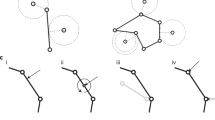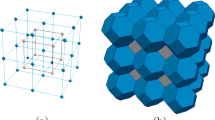Abstract
In this paper we further develop a novel approach for modelling heterogeneous objects containing entities of various dimensions and representations within a cellular-functional framework based on the implicit complex notion. We provide a brief description for implicit complexes and describe their structure including both the geometry and topology of cells of different types. Then the paper focuses on the development of algorithms for set-theoretic operations on heterogeneous objects represented by implicit complexes. We also describe a step-by-step procedure for the construction of a hybrid model using these operations. Finally, we present a case-study showing how to construct a hybrid model integrating both boundary and function representations. Our examples also illustrate modelling with attributes and dynamic modelling.
Preview
Unable to display preview. Download preview PDF.
Similar content being viewed by others
References
Adzhiev, V., Kartasheva, E., Kunii, T., Pasko, A., Schmitt, B.: Hybrid cellular-functional modelling of heterogeneous objects. Journal of Computing and Information Science in Engineering, Transactions of the ASME 4(2), 312–322 (2002)
Allegre, R., Galin, E., Chaine, R., Akkouche, S.: The HybridTree: mixing skeletal implicit surfaces, triangle meshes and point sets in a free-form modelling system. Graphical Models 68(1), 42–64 (2006)
Arbab, F.: Set models and Boolean operations on solids and assemblies. IEEE Computer Graphics and Applications 10(6), 76–86 (1990)
Armstrong, C., Bowyer, A., Cameron, S., et al.: Djinn. A Geometric interface for solid modelling. In: Information Geometers, Winchester, UK (2000)
Biswas, A., Shapiro, V., Tsukanov, I.: Heterogeneous material modelling with distance fields. Technical Report, Spatial Automation Lab, University of Wisconsin-Madison (2002)
Chen, M., Tucker, J.: Constructive volume geometry. Computer Graphics Forum 19(4), 281–293 (2000)
Cutler, B., Dorsey, J., McMillan, L., Mueller, M., Jagnow, R.: A procedural approach to authoring solid models. In: SIGGRAPH 2002: Proceedings of the 29th annual conference on Computer Graphics and interactive techniques, vol. 21(3), pp. 302–311 (2002)
Fougerolle, Y., Gribok, A., Foufou, S., Truchetet, F.: Boolean operations with implicit and parametric representation of primitives using R-functions. IEEE Transactions on Visualization and Computer Graphics 11(5), 529–539 (2005)
Frey, P.J., George, P.L.: Mesh Generation Application to Finite Elements, p. 816. Hermes Science Publishing, Oxford, Paris (2000)
Grimm, C.M., Hughes, J.F.: Modelling surfaces of arbitrary topology using manifolds. In: SIGGRAPH 1995: Proceedings of the 22th annual conference on Computer Graphics and interactive techniques, vol. 29, pp. 359–368 (1995)
Hachenberger, P., Kettner, L.: Boolean Operations on 3D selective Nef complexes: optimized implementation and experiments. In: Proc. of 2005 ACM Symposium on Solid and Physical Modelling (SPM), pp. 163–174 (2005)
Pasko, A., Shapiro, V. (eds.): Heterogeneous object models and their applications. Computer-Aided Design (Special issue), 37(3) (2005)
Jackson, T., Liu, H., Patrikalakis, N., Sachs, E., Cima, M.: Modelling and designing functionally graded material components for fabrication with local composition. Control, Materials and Design 20(2/3), 63–75 (1999)
Kartasheva, E., Adzhiev, V., Pasko, A., Fryazinov, O., Gasilov, V.: Surface and volume discretization of functionally-based heterogeneous objects. Journal of Computing and Information Science in Engineering, Transactions of the ASME 3(4), 285–294 (2003)
Kartasheva, E., Adzhiev, V., Comninos, P., Pasko, A., Schmitt, B.: Construction of implicit complexes: a case-study. In: Skala, V. (ed.) Proc. 13th International Conference in Central Europe on Computer Graphics, Visualization and Computer Vision WSCG 2005, University of West Bohemia, Plzen, Czech Republic, pp. 219–226 (2005) ISBN 80-903100-7-9
Kou, X.Y., Tan, S.T.: Heterogeneous object modeling: A review. Computer-Aided Design 39(4), 284–301 (2007)
Kumar, V., Dutta, D.: An approach to modelling multi-material objects. In: Fourth Symposium on Solid Modelling and Applications, ACM SIGGRAPH, pp. 336–345 (1997)
Kumar, V., Burns, D., Dutta, D., Hoffmann, C.: A framework for object modelling. Computer-Aided Design 31(9), 541–556 (1999)
Kunii, T.: Valid computational shape modelling: design and implementation. International Journal of Shape Modelling 5(2), 123–133 (1999)
Martin, W., Cohen, E.: Representation and extraction of volumetric attributes using trivariate splines: a mathematical framework. In: Anderson, D., Lee, K. (eds.) Sixth ACM Symposium on Solid Modelling and Applications, pp. 234–240. ACM Press, New York (2001)
Middleditch, A., Reade, C., Gomes, A.: Point-sets and cell structures relevant to computer aided design. International Journal of Shape Modelling 6(2), 175–205 (2000)
Ohmori, K., Kunii, T.: Shape modelling using homotopy. In: Proc. International Conference on Shape Modelling and Applications, pp. 126–133. IEEE Computer Society, Los Alamitos (2001)
Paoluzzi, A., Bernardini, F., Cattani, C., Ferrucci, V.: Dimension-independent modelling with simplicial complexes. ACM TOG 12(1), 56–102 (1993)
Park, S.M., Crawford, R., Beaman, J.: Volumetric multi-texturing for functionally gradient material representation. In: Anderson, D., Lee, K. (eds.) Proc. Sixth ACM Symposium on Solid Modelling and Applications, pp. 216–224. ACM Press, New York (2001)
Pasko, A., Adzhiev, V., Sourin, A., Savchenko, V.: Function representation in geometric modelling: Concepts, implementation and applications. The Visual Computer 11(8), 429–446 (1995)
Pasko, A., Adzhiev, V., Schmitt, B., Schlick, C.: Constructive hypervolume modelling. Graphical Models 63(6), 413–442 (2001)
Qian, X., Dutta, D.: Feature-based design for heterogeneous objects. Computer-Aided Design 36, 1263–1278 (2004)
Raghothama, S.: Constructive topological representations. In: Proc. the ACM Symposium on Solid and Physical Modelling, pp. 39–51 (2006)
Requicha, A.A.G., Voelcker, H.B.: Boolean operations in solid modelling: boundary evaluation and merging algorithms. Proc. IEEE 73(1), 30–44 (1985)
Rossignac, J.: Through the cracks of the solid modelling milestone. In: Coquillart, S., Strasser, W., Stucki, P. (eds.) From Object Modelling to Advanced Visualization, pp. 1–75. Springer, Heidelberg (1994)
Rossignac, J.: Structured Topological Complexes: A feature-based API for non-manifold topologies. In: Proc. the ACM Symposium on Solid Modelling, pp. 1–9 (1997)
Rossignac, J., O’Connor, M.: SGC: A dimension independent model for pointsets with internal structures and incomplete boundaries. In: Wozny, M., Turner, J., Preiss, K. (eds.) Geometric modelling for product engineering (1990)
Shin, K., Dutta, D.: Constructive representation of heterogeneous objects. Journal of Computing and Information Science in Engineering 1(3), 205–217 (2001)
Siu, Y.K., Tan, S.T.: “Source-based” heterogeneous solid modelling. Computer-Aided Design 34, 41–55 (2002)
Author information
Authors and Affiliations
Editor information
Rights and permissions
Copyright information
© 2008 Springer-Verlag Berlin Heidelberg
About this chapter
Cite this chapter
Kartasheva, E., Adzhiev, V., Comninos, P., Fryazinov, O., Pasko, A. (2008). An Implicit Complexes Framework for Heterogeneous Objects Modelling. In: Pasko, A., Adzhiev, V., Comninos, P. (eds) Heterogeneous Objects Modelling and Applications. Lecture Notes in Computer Science, vol 4889. Springer, Berlin, Heidelberg. https://doi.org/10.1007/978-3-540-68443-5_1
Download citation
DOI: https://doi.org/10.1007/978-3-540-68443-5_1
Publisher Name: Springer, Berlin, Heidelberg
Print ISBN: 978-3-540-68441-1
Online ISBN: 978-3-540-68443-5
eBook Packages: Computer ScienceComputer Science (R0)




